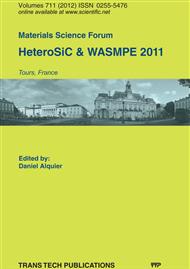[1]
M. Ruff, H. Mitlehner and R. Helbig, SiC devices: Physics and Numerical Simulation, IEEE Trans. Electron. Dev. 41(6) (1994), 1040-1054.
DOI: 10.1109/16.293319
Google Scholar
[2]
H. Morkoc, S. Strite, G. B. Gao, M. E. Lin and M. Burns, Large-band-gap SiC, III-V nitride, and II-VI ZnSe-based semiconductor device technologies, J. Appl. Phys. 76(3) (1994), 1363-1398.
DOI: 10.1063/1.358463
Google Scholar
[3]
M. Shur, SiC parameters handbook, http://www.ioffe.ru/SVA/NSM/Semicond/SiC.
Google Scholar
[4]
R. Schörner, P. Friedrichs and D. Peters, Detailed investigation of n-channel enhancement 6H-SiC MOSFETs, IEEE Trans. Electron Dev. 46 (1999), 533-541.
DOI: 10.1109/16.748873
Google Scholar
[5]
V. V. Afanas'ev, M. Bassler, G. Pensl, M. Schulz, Intrinsic SiC/SiO2 interface states, Phys. Stat. Sol.(a) 162 (1997), 321-337.
DOI: 10.1002/1521-396x(199707)162:1<321::aid-pssa321>3.0.co;2-f
Google Scholar
[6]
M. Bakowski, A. Schöner, P. Ericsson, H. Strömberg, H. Nagasawa and M. Abe, Development of 3C-SiC MOSFETs, J. Telecommun. Information Tech. 2 (2007), 49-56.
DOI: 10.4028/www.scientific.net/msf.483-485.801
Google Scholar
[7]
M. Bakowski, Status and prospects of SiC power devices, IEE J. Trans. Ind. Appl. 126 (2006), 391-399.
Google Scholar
[8]
E. H. Nicollian and J. R. Brews, MOS Physics and Technology, John Wiley, New York, 1982.
Google Scholar
[9]
R. H. Fowler, The analysis of photoelectric sensitivity curves for clean metals at various temperatures", Phys. Rev. 38 (1931), 45-56.
DOI: 10.1103/physrev.38.45
Google Scholar
[10]
V. V. Afanas'ev, Internal Photoemission Spectroscopy. Principles and Applic., Elsevier, 2008.
Google Scholar
[11]
C. N. Berglund and R. J. Powell, Photoinjection into SiO2: Use of optical interference to determine electron and hole contributions, J. Appl. Phys. 40(13) (1969), 5093-5101.
DOI: 10.1063/1.1657358
Google Scholar
[12]
H. M. Przewlocki, Internal photoemission characteristics of metal-insulator-semiconductor structures at low electric fields in the insulator, J. Appl. Phys. 85(9) (1999), 6610-6618.
DOI: 10.1063/1.370169
Google Scholar
[13]
H. M. Przewlocki, Theory and applications of internal photoemission in the MOS system at low electric fields, Solid-State Electr. 45 (2001), 1241-1250.
DOI: 10.1016/s0038-1101(00)00274-4
Google Scholar
[14]
S. K. Krawczyk, H. M. Przewlocki, A. Jakubowski, New ways to measure the work function difference in MOS structures, Revue Phys. Appl. 17 (1982), 473-480.
DOI: 10.1051/rphysap:01982001708047300
Google Scholar
[15]
V. V. Afanas'ev, M. Bassler, G. Pensl, M. J. Schulz and E. Stein von Kamienski, Band offsets and electronic structure of SiC/SiO2 interfaces, J. Appl. Phys. 79(6) (1996), 3108-3114.
DOI: 10.1063/1.361254
Google Scholar


